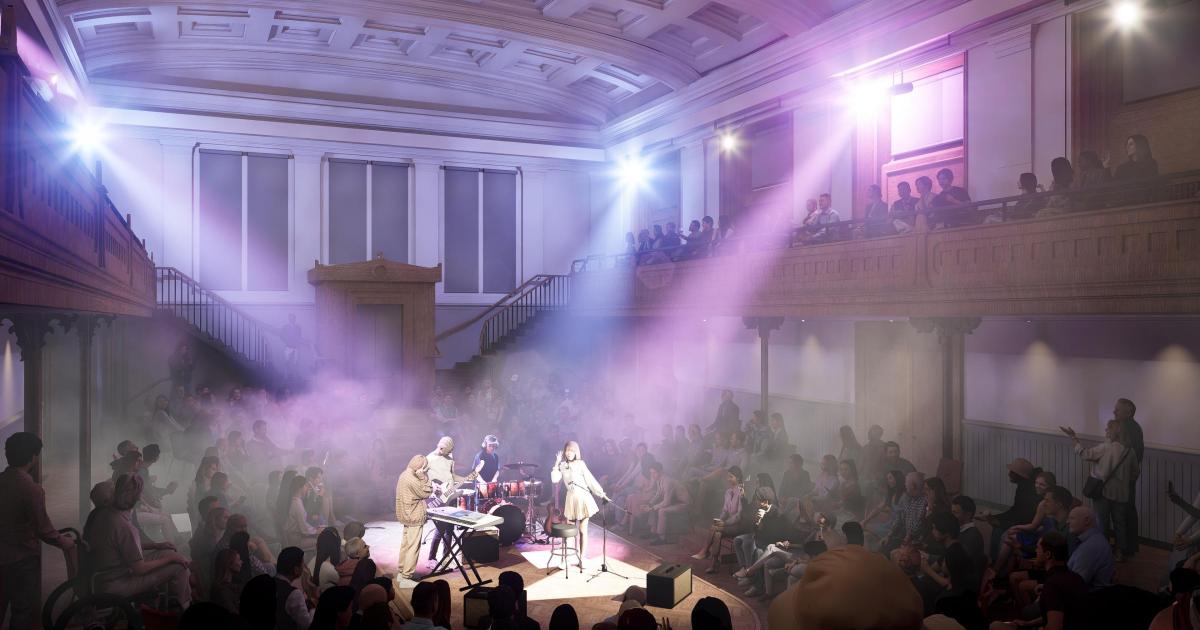The fly-through video features a tour of the three spaces for public performances being created inside the 19th century building, as well as a new visitor centre, an outdoor “piazza” and the first major new public gardens in the city centre for more than 200 years.
Read More:
The music centre, which is expected to create 18 year-round jobs will include spaces for performing, rehearsing and recording music, as well as a cafe, bar, offices and conference facilities.
Extensive work on the project, which secured final permission in July 2024, has already been carried out in and around the historic building ahead of the main construction project starting early next year.
The new National Centre for Music is expected to open in Edinburgh in 2027. (Image: Richard Murphy Architects)
Designed by architect Thomas Hamilton, the A-listed landmark dates back to 1829, but has been largely unused since the school relocated to the Barnton area in 1968.
It was long mooted as a potential new parliament building in Edinburgh before being proposed as the home for a national centre of photography.
null (Image: Richard Murphy Architects)
Plans to turn the building into a new luxury hotel boasting spectacular views of the city were being pursued when rivals proposals for a music school and concert venue at the site first emerged 10 years ago.
The vision for the National Centre for Music has been mainly backed from the outset by the Dunard Fund, the charitable trust created by the American-born arts philanthropist and former concert pianist Carol Colburn Grigor, one of the biggest private supporters of Scottish cultural organisations in modern times.
Spaces for performing, rehearsing and recording will be created in the new National Centre for Music in Edinburgh. (Image: Richard Murphy Architects)
However the Calton Hill project has also secured a pledge of £5m worth of support from the National Lottery Heritage Fund, as well as a further £3.35m from two other charities, the Julia Rausing Trust and the Woolfson Foundation.
A new vision for the music centre, which will be able to host concerts with as a capacity of up to 300, pledges that it will create a “nurturing and inspiring environment where Scotland’s musical history is made.”
Edinburgh’s new public gardens for more than 200 years will be created in the grounds of the new National Centre for Music on Calton Hill. (Image: Richard Murphy Architects)
It adds: “Reawakening a spectacular Scottish heritage site, the National Centre for Music will become an energising force in Scotland’s music sector, and an iconic cultural destination.
“Through our programmes and partnerships, Scotland’s musical communities will come together, music will change peoples’ lives, and Scotland will stay firmly at the forefront of global musical boldness.”
DJ and TV presenter Edith Bowman has provided the voiceover for the short film, which states: “The Royal High School is one of Scotland’s most important, but vulnerable historic buildings.
“It’s for a major transformation into a National Centre for Music just 10 minutes walk from Waverley Station.
“Visitors will be met by beautifully landscaped gardens. Accessible paths will flow to a visitor centre.
“In the stunning main hall, visitors will be immersed in the unique interior, heritage and intimacy of this room.
“Either side of the main performance hall are two octagonal-ceilinged rooms, will become small, intimate performance spaces.
“Moving towards the historic bell tower, a new provide relaxing seating, or can be set for outdoor performances, a fitting setting for where Scottish musical history will be made for decades to come.”
The short film has been created for the project by Edinburgh-based architect Greig Penny.
Mr Penny said: “The Royal High School is one of Edinburgh’s most architecturally significant buildings, so it was an honour to bring the new plans to life in such a detailed way.”
Jenny Jamison, chief executive and creative director of the centre, who has led the project team since 2024, added: “We wanted to give our current stakeholders, local communities, future audiences and potential partners from across Scotland’s music sector a true sense of the exciting plans for the National Centre for Music.”
A spokesperson for the project said all enabling works “on track” to be completed by the end of the year.
The spokesperson added: “Since February this year, a specialist team have been working to understand the current condition of the building and gain further information on the structure of the historic site.
“These enabling works have included a variety of structural surveys including a building condition survey and ground penetration radar survey to determine the viability of the design plans for The National Centre for Music. The results have re-affirmed the viability of the plans and informed slightly updated designs which we have brought to life with new digital architecture films.
“So far, the works have included assessments of the rock levels and composition within the historic main hall to inform the viability of creating a public foyer and interconnecting corridor, enhancing the building’s flow and visitor accessibility.”
Carol Main was recently appointed as the first chair of the music centre’s board after leading the charity Live Music Now Scotland, which supports musicians at the outset of their careers, since the 1980s.
She said: “As a culmination of what I have strived to do throughout my career in music in Scotland, I shall endeavour to encourage and support all those involved with the National Centre for Music in enabling a broad mix of people to come together with spirits lifted and lives enhanced through the best possible experiences of music in this extraordinary new setting.”
